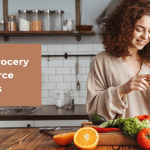Last Updated: 8th June, 2023
Picture this: You are home with your family, it’s a regular Sunday morning, the day of the week you lined up a number of personal errands due to a busy working week. Yet, you are unable to find time as it is also the only day your family is most demanding of your time. This is when you jump to an option where more than half your job is done with a click on your phone, saving you from getting ready and visiting a store, choosing routine-use groceries, lining up to pay, and carrying it all back home.
Online Grocery Shopping – Industry Overview
With big names like Amazon launching Amazon Fresh and Prime Pantry, it is quite evident how the grocery stores going online is the new trend. The comfort and convenience is pushing the consumer to choose the online way of shopping for their groceries and household goods.
A 54% of the grocery retailers today offer a mobile application for their consumers to order their groceries for home deliveries. Understanding what attracts their customers, the ordering is supplemented with e-coupons, deals, loyalty offers, maintaining traction and improving their sales. These practices contribute immensely to the U.S. grocery sales spike, from 17.5 billion USD in 2018 to a 30 billion USD by 2021.
Watch the video to know more about the grocery shopping industry.
Embracing Technology – Win-win Strategy for Entrepreneurs
The experience one gets while shopping at the store will always remain unmatched. When the consumer gets the look and feel of the item, the sale is definitely secured better, than any other channel. But the consumer today is lured by on-shelf deals and offers, the striking price tags with discounts, ends up buying and stocking a lot more than needed at times.
The real-question here is, whether the regular local retailers and merchandisers are ready to accept change, barring what they gain with direct foot-fall at the store. This is where e-commerce taps a point.
Offering a streamlined customer experience, where consumers can add, remove, and change items just like in-store shopping contribute immensely to the evolving digital models of retail. Adding to convenience with features like multi-cart, multi-payment, scheduled orders, and home deliveries with electronic proof-of-delivery, equipped exquisite marketplaces and portal solutions, provide for the omnichannel strategies to leverage business of small-time grocery retailers.
How Marketplaces are Wiring and Connecting Grocery?
The global pandemic has created a situation where both sellers and buyers evolved and shifted to online options. The grocery sector, which was experiencing a slow transition from the offline brick and mortar stores to online selling, has now become an inevitable shift. With people relying on home-cooked food, groceries from local trusted vendors, the demand for the online shift of grocery and essentials has come out most prominently.
As the grocery market becomes more and more accessible, and people have started choosing the online ways to shop for everyday essentials, e-commerce marketplaces have a huge role in this digital journey. They have made the offline-to-online migration as well as online additions very attractive.
Go Local
Not only do people look for buying their kitchen and everyday household items from trusted vendors, they want deliveries scheduled as per their routines with easy payment options. Their vendors know which brand a household uses, and what product goes to what consumer.
To keep this bond intact marketplaces have now equipped with location trackers, enlist local stores in a defined radius of the buyers, providing the sellers to serve their existing customers in a brand new way.
Advanced features like local currency payment facilities, contact-less deliveries, self-pick ups, and delivery scheduler give the consumer a local and at-home feeling. This will keep them bonded to their trusted stores with their favorite products.
Advanced Analytics
Supermarkets have a lot to manage every day. Their daily sales and supplies need to be tallied and sorted. Smart e-commerce marketplaces offer smart dashboards with clear calculated numbers to make quick and wise business decisions every day, prompting the legacy process followers to migrate easily.
As per a KPMG study, out of the 77% retailers collecting data, only one-third of these actually analyze this to improve their planning and management. Analytical dashboards for the admins or marketplace owners and the sellers on the marketplace allow them easy and quick revenue, number of new subscriptions, sales per vendor, and a lot more.
An analytics feature in the marketplaces helps attract local small-time grocery retailers assuring them of smooth processes while on this dimension of business.
Automation & Improved Management
Bringing offline grocery retailers, accustomed to putting trained resources at work for every little task, onto online portals, to register their stores, create comprehensive catalogs, take online orders, and deliver door-to-door, is a compelling task.
E-commerce companies and their new-age approaches have made possible the augmentation of businesses for the offline small-time grocery shop owners through adding digital abilities to their profiles, where they can optimize and take in their stride all the opportunities that come their way.
Automated tracking, order listings, route optimizations, delivery management, commission and revenue calculations, have helped the traditional retailers to pace up their businesses rapidly on the marketplace domains, without incurring any additional costs.
Admin to Drivers – Augmented Last-mile Delivery
The classic stroke however is the impact that is created by the delivery features. Marketplaces have totally struck the chords with the likes of tech-savvy consumers and created smarter business ecosystems where the local grocery retailers can take advantage of newer technologies to strengthen the connections with their customers.
Improved last-mile delivery features with schedulers, order tracking, and driver connectivity have retained the trust between the retailers and their customers. With complete control and convenience for all stakeholders, beginning from the admin, vendor, buyer to the driver, the services have not only improved but enhanced consumer behavior and profits for all.
Saving on Marketing Budgets
Marketing plays a key role in sustaining new business channels. Local small-time offline retailers definitely hesitate in spending on something they have thrived without. But e-commerce marketplaces provide them a platform they never asked for.
With banner ads and product listings on the marketplace homepage and social media posts, at minimal costs, the vendors migrating to online platforms can now score above their competitors without any marketing expertise and strategy building.
The offline-to-online transition has given them a new dimension to play on, elevating their customers’ as well as their own journeys while shopping for groceries, and running households every day.
Customer service – A New Value Proposition
Every time a new business arm or service is launched, its value-add to the main business and its customers has to be significant to be justified. When elevating from offline-to-online, how the online sales channel adds weight to the primary business audience is most important.
For the consumers, who used to go to their nearby grocery stores, pick out items of their choice, day-after-day, felt responsible, independent, and confident while paying. Due to unexpected circumstances forcing them to stay home, when they have to choose an alternative buying channel, the confidence is bound to fall short.
Marketplace owners and e-commerce companies understood the pain point and hit the jackpot. Creating hyper-local marketplace solutions that enlist stores in the vicinity, within a defined radius, keeping sellers and buyers linked, ensuring better business models.
Benefits being: the sellers are already acquainted with their known customers’ choices, don’t have to try too hard to bring them onto the new shopping channel; plus, when they add value to services for their existing customers, they end up with improved traction due to better experiences leading to indirect marketing via word of mouth.
So ultimately, a new dimension to offline sales becomes a new lifeline, adding value to consumers lives as well as the offline retailers and their business.
Growth & Impact on the Retail Ecosystem
With more and more offline retailers now choosing to add an online portal to their stores, the retails sector has witnessed an unprecedented spike in its online and e-commerce segments. As the adoption of technology takes online retail to new heights, it also enhances its reachability with augmented efficiency.
This expansion to different devices like smartphones, and with different technologies like 3G, 4G, wi-fi and more is ultimately contributing to improving customer migration to online shopping. Leading to increasing revenues with better customer satisfaction, the online retail segment, or the e-commerce has given the retail ecosystem a complete lift.
The impact is huge and so is the ever increasing demand which has coerced the big players in e-commerce to create better marketplace systems. Dynamic e-commerce solutions are now available with:
- Improved admin controls
- Advanced management tools
- Seller registrations with elaborate catalog listings
- Quick store listings for the buyers
- Convenient buying experience
- Improved driver or delivery features
- A more local/regional touch
- Numerous payment options
The solution providers have filled the gap created during the pandemic lockdown, when both buyers and sellers faced a setback with their routines. With monetary lay-backs for the retailers, a psychological lag was being observed in communities due to not being able to carry on happy activities like spending time with friends and shopping.
Author’s take
With affordable and turnkey solutions now available, taking the leap from offline stores to online portals and platforms for small-time local grocery retailers is a cake-walk.
Helping them launch, connect and serve their customers efficiently, augmenting their outreach, the e-commerce marketplaces have changed the dynamics as well as the future of our favorite nearby grocery stores.
Now when at home on a lazy Sunday, or while at work, groceries and essentials and a lot more can be easily received, from our routine grocery stores, while staying safe and taking care of the family as well.
Success Stories – Offline to Online
Making such transitions possible and developing such turnkey solutions for legacy grocery and other retailers, is FATbit technologies. With numerous success stories of neighbourhood retailers going big with additional online services added to their profiles, some fall into the FATbit basket of glory too.
FATbit has helped clients stuck with alternate e-commerce solutions, unable to figure their way out of so many queries and uncertainties. Solving their issues and answering all their questions with our hyper-local e-commerce software solution, Growcer, they could launch their grocery marketplaces with the features and functionalities of their choice.
When a UK-based businessman, looking to purchase a complete software solution for a marketplace approached the Growcer team at FATbit, he was already aware about competitor offerings and could not strike a deal as was unable to get through with a location-wise set-up, where a radius is defined to locate and list the neighbourhood grocery stores. After a thorough walk-through of what Growcer had to offer, he immediately shifted and launched his marketplace ‘Docaan’ powered by Growcer, with all the features and functionalities of choice.
Running successfully, along with himself, he has been able to change the fate of almost all the local offline retailers, bearing the brunt of the lockdown.
Similar such queries have come up from the US and solutions have been deployed with similar satisfaction quotients with our fully customizable and quick-to-launch Growcer.
We provide a power packed platform, equipped with all the features for anyone interested in launching a hyper-local e-commerce marketplace in any part of the world. The solution is well developed keeping in mind global likes and cultures.







